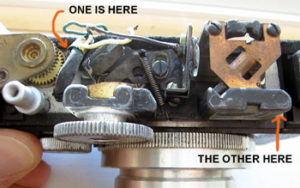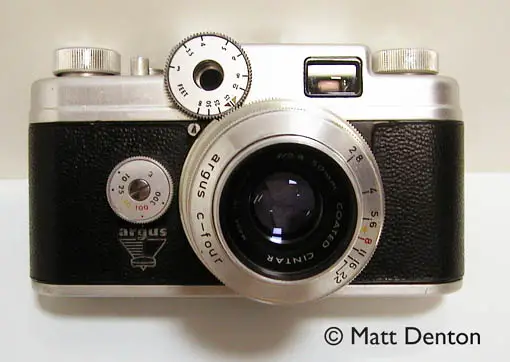- Produced 1951-58 Argus Cameras, Inc., Ann Arbor, MI USA
- Film type 135 (35mm)
- Picture size 24 x 36mm
- Weight 25.6oz (725.8g)
- Lens Argus Coated Cintar 50mm 1:2.8 (unusually fast for a triplet)
- Filter Size accepts Kodak Series VI adapter no. 26 or 33mm slip-on
- Focal range 3′ to infinity
- Shutter leaf
- Shutter speeds B, 1/10-1/300
- Viewfinder coupled rangefinder
- Exposure meter none
- Hot shoe
Overview
The Argus c-four is the very worthy successor to the once-popular C3. Simple, handsome and rugged, it’s got a great comfortable feel like the German and Russian classics at a significantly smaller price. Shutter speeds are limited to 1/10, 1/25, 1/50, 1/100, and 1/300 (kind of like a FED!) but there is an actual hotshoe, activated by an M-F switch beneath the eyepiece. It has a removable back for film loading similar to old Contax/Leica and Russian copies of those cameras. Takes very nice pictures with its sharp coated Cintar lens. And it’s virtually vibration-free.
The c-four was itself succeeded by the more collectible but reportedly less user-friendly c-forty-four, which uses very nice German Cintagon lenses. There exists an uncommon version of the c-four that has interchangeable lenses, it’s known as the ‘Geiss-modified c-four’ and can be spotted by a telltale lever on the right of the lens mount. This camera, though not as sought-after as the c-forty-four, is supposedly much more user-friendly and probably a better purchase if you can find one and the hard to find Enna-Werk Lithagon lenses it accepts.
Repairs
When I got my first one there was a very old roll of color film inside, and the chemicals had caused corrosive buildup on the aluminum wind spool. I cleaned off as much of it as I could with vinegar and then scraped off the rest with emery cloth till it was smooth and corrosion-free. It’s a little pitted but perfectly functional.
Now, my first test roll came back all out of focus. Looking closer I saw that it was in focus, just never on my intended subject. I tested the rangefinder at all marks between 3 and 50 feet and found it to be off by several feet. I realized while testing that the external gears were slipping, something I wasn’t sure if I could fix. I did take it apart (easier in fact than the C3 for getting at the shutter & rangefinder) and cleaned the rangefinder mechanism with ether, and cleaned all the glass and metal with Windex. The whole thing comes apart with just flat-blade screwdrivers, typical of early Argus and Kodak, none of this crazy spanner stuff for these old American classics! I also cleaned all the brass inside the rather primitive lens movement mechanism but none of this helped the fit of the gears, the teeth being simply too worn from use to mesh without slipping.
FOLLOWUP and FIX: So I did get myself a parts c-four and discovered something that made me feel a little dumb… The second camera had a wobbly focus wheel and something rattling inside the top cap. Turned out to be a loose screw, one of only two that holds the entire RF mechanism to the body (see picture below). A lot of strain is put on these screws by turning the focus wheel, and they can loosen and the RF mechanism can shift (there’s play for adjustment), causing slippage between the focus wheel teeth and the teeth on the lens. I went back inside my original C4 and quickly saw that’s all its problem was — the RF mechanism had shifted just enough to cause slippage, moving it over and retightening the screws fixed the problem. (Weak!) Locking washers would have been a good idea, or you can put a dab of clear nail polish on those screw heads to deter them from loosening again. The good news: my second camera, fixed, was actually nicer than the first once and came with the sweetest oil-tanned hand-stitched leather case!

PS it’s good to have a loupe and a piece of ground glass 35mm wide to calibrate the rangefinder. You can fake a piece of ground glass by cutting some glass with a metal straightedge and a glass cutter, then putting regular semitransparent tape on one side that will act as the frosted glass. Take off the camera back, put the glass between the film guides with the ‘frosted’ side towards the front of the camera, and use your loupe to focus infinity with the shutter open to ‘B’. It’s a little tricky, but once you have infinity set, mesh the gears and tighten the RF mechanism in place.
By the way, this is one of the easiest cameras to work on that I’ve come across. A couple of little flathead screwdrivers will do it, you can get in easily and lightly lube the RF mechanism without dismantling much. The lens itself has a screw that keeps it in a track, take it out and you can unscrew the lens for cleaning. BUT WAIT — before you do that, set the camera to infinity and mark with a pencil the point where the bottom of the lens comes on the geared piece below. It is not only possible, it is highly likely that you will put it back incorrectly if you do not do this and no amount of RF adjusting will make it focus properly. Once you get the lens off you can lift off the geared portion and put some synthetic grease under it for even smoother focusing. Put it all back and check infinity focus with a loupe and ground glass.
Tips & Tricks
Don’t bother trying to focus with your finger on the distance wheel — unlike the C3 it’s much easier to focus the c-four by simply rotating the lens barrel.
Like other rangefinders of the day there is not only NOT parallax correction, there is not even a bright frame finder. What this means is that at around 4′ you start to see a noticeable difference between what you framed and what arrives on film, and at 3′ it becomes a pronounced effect (heads cut off, etc). If shooting that close give yourself some room for error and move the scene within an imaginary parallax bright frame, I think we all know what they look like by now.
I was kind of amazed that it had a real hot shoe considering the age and simplicity of this fully manual camera – it fires my little Pentax 160AF very consistently, however the shoe itself is very tight and I would probably bend the wings up a little if this were a frequent user. Strange, that – I’ve found more often than not that pre-1970 cameras won’t fire my newer flashes and sometimes vice versa. But the leaf shutter means that it syncs at all speeds, which is very nice, particularly when using fill flash.
No strap lugs! What did they think this was, a FED? Heh.
